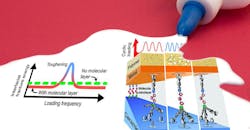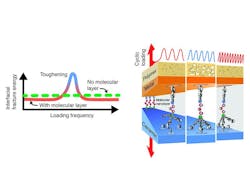Nanoglue Gets Stronger Under Dynamic Loading
A team led by engineers from Rensselaer Polytechnic Institute has unlocked the behavior of new material that could open the door to new possibilities in materials engineering. The team discovered that oscillating loads at certain frequencies can increase the strength of composites several-fold, so long as the composites have a molecular layer of a secret ingredient it calls “nanoglue.”
“Unearthing, understanding, and manipulating nanoscale phenomena at interfaces during dynamic loading is a key to designing new materials with novel responses for applications,” says Ganpati Ramanath, the John Tod Horton Professor of Materials Science and Engineering at Rensselaer. “Our work demonstrates that introducing a nanoglue layer at an interface of a layered composite can mechanically and significantly toughen that composite at certain loading frequencies.”
Ramanath and his team of collaborators found that, at certain loading frequencies, the energy required to fracture a nanoglue-modified polymer-metal-ceramic composite tripled and exceeded the static loading fracture energy. This behavior was unexpected and is significant, because fracture energy is typically lower during cyclic loading than during static loading. Such frequency-dependent toughening was observed only when a nanoglue layer was used to bond the metal and ceramic.
The illustration on the right shows a cross-section of a polymer-metal-nanoglue-ceramic composite. The graph shows the frequency-dependent toughening phenomenon.
The results also show that although the nanolayer is necessary for toughening, the frequency range and extent of toughening depend primarily on the mechanical properties of the polymer in the composite. Specifically, the nanoglue facilitates load transfer across the metal-ceramic interface and dissipates energy in the polymer through plastic deformation, leading to an increase in fracture energy.
“Our discovery opens up an entirely new set of possibilities to design composites with novel responses using different combinations of polymers and interfacial nanolayers. For example, we could build a completely new class of smart composites that significantly toughen, or perhaps even self-destruct, at certain frequencies,” Ramanath says.
“Manipulating the coupling can make composites stronger under loading conditions we have traditionally tried to avoid and, hence, vastly expand the scope and improve the performance of composites in applications,” says Michael Lane, a chemistry professor at Emory & Henry College.


